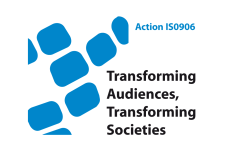- About the Action
- Events
- PhD workshop - Ljubljana 2014
- Action Open Conference - Ljubljana 2014
- New Media and Participation conference - Istanbul 2013
- Belgrade meeting 2013
- Media literacy research and policy - Brussels 2013
- ICA Pre-Conference 2013
- Tampere meeting 2013
- Budapest workshop 2012
- Milan meeting 2012
- Brussels PhD workshop 2012
- Brussels Action workshop 2012
- London meeting 2011
- Zagreb Conference 2011
- Lisbon meeting 2010
- Affiliated events
- WG 1
- WG 2
- WG 3
- WG 4
- Cross-WG
- Output
Audiences: a cross generational dialogue. A faculty-mentored cross-generational doctoral workshop on audiences and audience research, Brussels, 11 April 2012
Sorenssen, I. (2012). Audiences: a cross generational dialogue. A faculty-mentored cross-generational doctoral workshop on audiences and audience research, Brussels, 11 April 2012. .
http://crossgenerationalworkshop.wordpress.com/Abstract: PhD thesis: The construction of tween identity through the Disney Tween phenomenon (see abstract in attachment). Questions discussed during the workshop (among others): a. How can we move the field of audience research into research of audience and consumption? One suggestion is looking at theory from the field of fan studies, as a way of developing this consumer/media field. What possibilities are there in merging consumption and audience research, and what are potential pitfalls of such a merger? b. The concept tweens comes from the marketing realm and Disney uses it frequently. An issue I would like to discuss is how media may function as a marketer’s construction of the concept of tweens and how this leaks into a general public conception of the concept. c. There appears to be a stimuli-response model prevalent in the general public in which children in relation to consumption are considered as fragile and in need of protection. In their relation to the paratexts generated by the media industry, the children in the study may be viewed either as victims of marketing, or as eager active consumers. How can we as researchers contribute a nuancing of this model?

